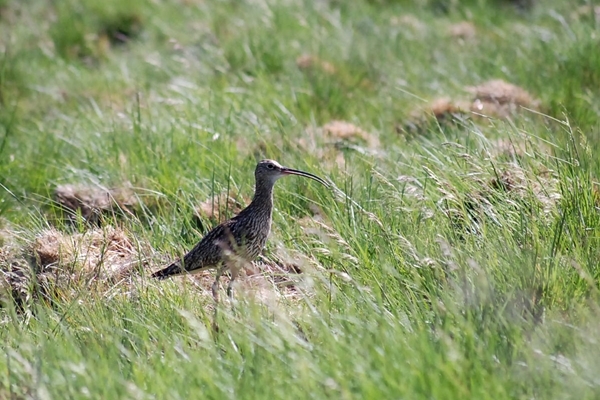
CURLEW have arrived on a Welsh moor again that is conserved by the Powys Moorlands Partnership (PMP) project.
Britain’s largest wading bird was spotted by visitors from mental health charity Talgarth Mind, during a visit to Ireland Moor, which is part of the three-year PMP project.
The group wanted to see how the work of moorland managers is helping to restore the heather habitats together with efforts to protect the ground-nesting birds from predators.
This work is being done as the iconic curlew, in Wales, has declined by 81% over a 13-year period.
“Sadly, the dramatic decline of these long-lived birds, who return to the same nesting site each year, means that they are at great risk of extinction,” explained Sue Evans, Director Wales at Game & Wildlife Conservation Trust (GWCT).
“Although it is a wonderful time of year when the curlew comes back home, the devastating truth is that this bird is in big trouble and its chances of breeding success is slim. It is just too vulnerable for them.”
“We know through our GWCT science that, as well as getting the habitats right, predator control has been proven to be critical in the success of these birds fledging.
“They are under pressure and with the many projects taking place around the UK to find ways of safeguarding the curlew, we have to be honest in our approach before we lose this beautiful bird altogether.”
Promoted by the PMP to help reverse these declines is Curlew Country, a project hosted by GWCT and based in the Shropshire hills and Welsh Marches, led by Amanda Perkins.
She said: “We have used a range of techniques such as temporary electric fencing around nests to increase hatching success and put cameras on curlew nests to monitor the situation but lost all eggs and chicks in two years mainly to predation.”
Curlew Country obtained a licence by Natural England to rear and release curlew chicks in Shropshire to the point of fledging, a process known as headstarting.
“Curlew really can unlock the potential to so many environmental benefits which farmers are keen to deliver to save these birds, but the ageing generation of curlew and the senior generation of farmers who are familiar with them and other more abundant wildlife are both being lost to us. The clock to save curlew is ticking fast,” Amanda added.
You can celebrate this precious species on World Curlew Day on April 21st.
Notes to editors
The Game & Wildlife Conservation Trust – providing research-led conservation for a thriving countryside. The GWCT is an independent wildlife conservation charity which has carried out scientific research into Britain’s game and wildlife since the 1930s. We advise farmers and landowners on improving wildlife habitats. We employ more than 60 post-doctoral scientists and other research staff with expertise in areas such as birds, insects, mammals, farming, fish and statistics. We undertake our own research as well as projects funded by contract and grant-aid from government and private bodies.
For information, contact:
Eleanor Williams
Telephone: 07592 025476
Email: press@gwct.org.uk